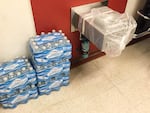Major facility projects are wrapping up for the school year just as students head to classrooms in Oregon’s largest district.
Portland Public Schools made several re-structuring moves this summer, using funds from bond measures voters approved in 2012 and 2017. The district is touting some accomplishments, including eradicating lead from its centrally-located drinking fountains, even as officials had to succumb to the reality of construction delays at one school.

Portland Public Schools has done air quality testing and enacted facility upgrades to prepare Harriet Tubman Middle School for students in the 2018-19 school year.
Rob Manning / OPB
One of the campuses for the Beverly Cleary K-8 program, the Fernwood building on Northeast 33rd Avenue, won’t be ready when school opens. School officials announced last week they won’t open Beverly Cleary Monday, but will instead delay until Tuesday, Aug. 28.
Principal John Ferraro told parents that the delay was decided after a visit Thursday by board members and district leadership.
“They saw how construction activity in the building this past week has made it challenging for our teachers to access their classrooms, making it impossible to be prepared for students on Monday,” Ferraro said. “All were in agreement that we must delay the opening of Beverly Cleary by one day to allow more time for our teachers to prepare classrooms and allow proper cleaning to take place before our students return.”

Bottles of water are piled next to a closed drinking fountain at Sabin Elementary School in Northeast Portland.
Rob Manning / OPB
Changes at Fernwood are just part of complicated alterations across the east side of the district.
One of the biggest is the splitting of K-8 programs into elementary and middle schools in North and Northeast Portland. Ten schools are part of that shift.
In inner North and Northeast Portland, Harriet Tubman is opening as a middle school. The school overlooking Interstate 5 has spent years in various uses, from running a girls program to housing students at Faubion K-8 while that school was rebuilt. It will house the middle-grade students who would formerly have attended Boise-Eliot, Martin Luther King Jr., Irvington and Sabin schools, as they change from K-8 programs to elementary schools.
Parents have questioned the air quality at Tubman, due to its proximity to Interstate 5. The district learned earlier this year that the air quality is poor enough that students should limit time spent outside and that the district should continue to take steps to clear the air inside.
Changes are also afoot farther east, involving a handful of schools: Roseway Heights is changing from a K-8 to a middle school, while K-8 programs at Lee, Scott and Vestal schools are shrinking to K-5 elementaries. Then there’s Rose City Park, which is transitioning from housing two grades of the Beverly Cleary School and the ACCESS Academy for talented and gifted students, into a neighborhood elementary school.
The changes to Tubman and Roseway Heights aren't cheap. School board members had to divert $11.4 million from the 2017 bond that voters approved to upgrade those buildings.

The back of Harriet Tubman Middle School is just a few dozen yards from heavy traffic on Interstate 5.
Rob Manning / OPB
At the same time, after a school year's worth of uncertainty for students, parents and staff at the ACCESS Academy, PPS decided to split the program into two parts to share space in two other PPS buildings. Younger students are headed to Vestal; older students will go to Lane Middle School.
But the biggest change that most students will see relates to drinking water: school fountains are back on. After confirming elevated lead levels in school drinking water in spring 2016, PPS went more than a full school year with the fountains turned off.
Last school year, PPS was steadily remediating problems and returning fountains to working order. But when classes ended last June, many students were still in schools where the fountains couldn’t be used. District officials said water should be flowing — at least in common areas and hallways — when school starts.
"They're going to see a lot of drinking fixtures in common areas; that means gymnasiums, cafeterias, hallways, kitchens," said senior director for environmental health and safety John Burnham in an appearance last week on OPB's "Think Out Loud." "Those are going to be turned on, and they're going to be labeled that way with signs.
"They’ll see a few in those areas that need more work.”
Many of the changes requiring construction work relied on a bond measures PPS voters approved in 2017. The $790 million bond dedicated $150 million for environmental health problems, including lead in school drinking water. The bond campaign focused heavily on the district’s lead problems, though the vast majority of money in the bond was intended for rebuilds or major renovations at four large school buildings: Benson, Lincoln and Madison high schools, and Kellogg Middle School.
The school board is now wrestling with how to manage those large projects, as building plans are coming in as much as $190 million above what bond funds can cover.
